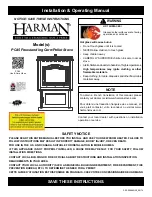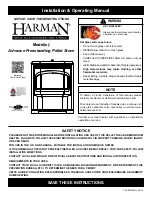
Gaskets
The rope gaskets in both doors will need regular inspection to check the condition and ensure that
the doors seal and full control of the air supply to the fire can be maintained.
Firebox glass
Clean the firebox glass only when cool with a specialist glass cleaner. Use of any abrasive cleaner
will scratch the glass and make subsequent cleaning more difficult.
Chimney
It is important to have the chimney cleaned at least once a year.
Regular inspection and cleaning of the internal components of the Range can indicate if the
chimney requires more frequent cleaning.
If the Range has been unused for an extended period (during the summer) the chimney should be
checked by a competent person before use.
Note
All parts that are in direct contact with the fire (grate, baffle, back and side air boxes) are
considered as normal wear parts. Their life will be dependant on how vigorously the Range is
operated and they must be inspected and maintained on a regular basis. If they become worn,
damaged or not positioned correctly, the top, sides or back of the Range will be exposed to
excessive heat and may be damaged.
Remember
15
9 – Fault Finding
Fire will not burn
The fuel is too wet and not suitable
Air inlets to the Range are blocked
The flue is blocked or restricted
Inadequate air supply into the room
Soot build up on glass
Fuel is too wet
Fuel pieces are too large and “smouldering” rather than burning.
The Range operating temperature is too low
The Range is being run too “slow” with not enough air
Poor chimney draft
Too little secondary air washing over the window
Excessive wear on internal parts
Range fired too vigorously
Too little air passing through the bottom grate
Use of wood that is too dry (eg wood from old furniture)
If the Range is not to be used for an extended period, set both air controls to half open to
allow an airflow through the stove and avoid condensation.



































